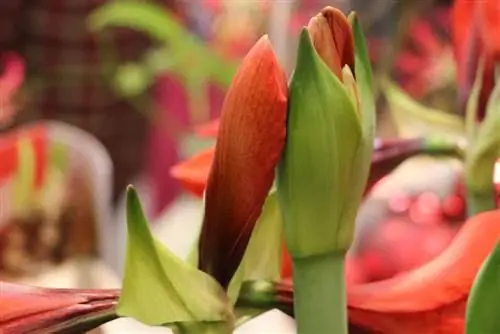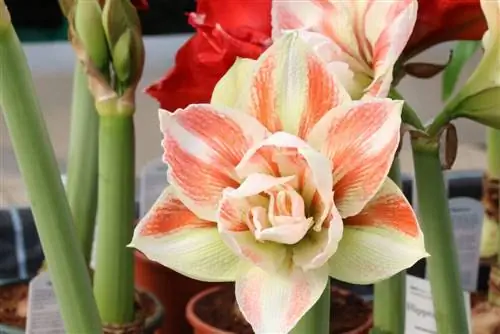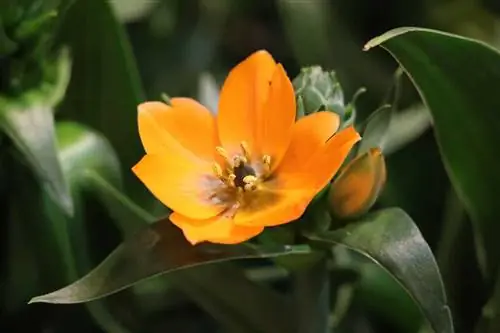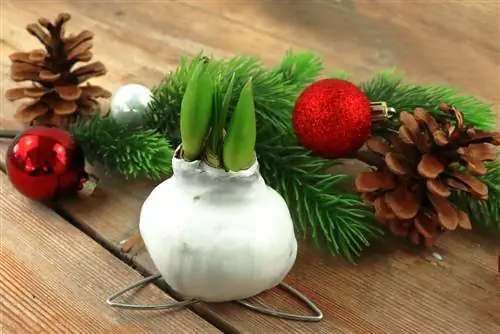- Author admin [email protected].
- Public 2023-12-17 03:39.
- Last modified 2025-01-24 12:45.
The amaryllis blossom is as much a part of winter as the Christmas tree. Every autumn, the thick amaryllis bulbs are available in stores and, given sufficient warmth and humidity, they will soon produce decorative red, white, yellow or patterned flowers. Anyone who knows the needs of the beautiful plant, also known as Knight's Star, can enjoy the splendor of its flowers for several years. We'll show you what you need to consider.
Amaryllis and Knight's Star
Strictly speaking, the amaryllis and the knight's star are not the same plant. Both belong to the amaryllis family. The real amaryllis, also known as the belladonna lily, comes from South Africa. It first forms leaves and then flowers. The knight's star comes from South America. The flower appears before the leaves. Today knight's stars (Hippeastrum) are mostly offered under the name Amaryllis.
The Life Cycle
Like all subtropical plants, the knight's star is adapted to rainy and dry seasons. In order to optimally oversummer and overwinter the popular houseplant, the three life cycle phases of the plant must be observed:
- December to February: flowering time
- March to July: growth phase
- August to September: rest period
Four step instructions
The amaryllis requires different care in every season, we have now broken this down roughly by month.
1. Preparation for flowering (November)
To prepare for flowering, take the amaryllis bulb out of its winter quarters in November. Place these in a flower pot or tall glass. The diameter should be at least 12 centimeters. The onion is placed halfway in soil. All roots must be covered. Fill the pot with loose, well-drained potting soil. Onions that have been overwintered in a pot can be planted in a larger container. We recommend placing knight stars in new substrate at least every four to five years. Make sure the bulb is planted at the same height as before.

Do not water the plant for two weeks. Place the pot in a warm, bright location. The first flower stalk will soon appear. When it is about 10 centimeters long, you can water the plant once a week. To stimulate flowering, fertilization with flowering plant fertilizer is recommended.
Note:
Be careful when planting the bulb. The roots must not be injured.
2. Care during the flowering period (December to February)
Six to eight weeks after planting, usually in December, the first flowers will be visible. The plant then needs to be watered regularly but sparingly. Knight stars neither like dryness nor waterlogging. After watering, wait a few minutes until the flower pot is saturated with water and remove the excess water. Waterlogging causes the roots to rot and the plant to die. During flowering, the knight's star needs a bright, warm location. The optimal room temperature is 20 to 22 degrees Celsius. No fertilization is required during flowering.
3. Oversummer after flowering (March to July)
After flowering, all flowers are removed with a sharp, clean knife. Leave the leaves standing. After the Ice Saints in May, place the plant on the sunny balcony, on the terrace or in a bright window. During this time, the plant can collect sufficient nutrients and form buds for new flowers. Fertilizing with a flowering plant fertilizer is essential during the summer. The temperature should be consistently 20 to 28 degrees Celsius. If night frosts are imminent, the houseplant should be brought indoors. The knight's star can survive hot temperatures of over 30 degrees Celsius for a short time without being damaged.
Tip:
If you have a sunny garden, you can keep the knight's star in the bed over the summer. We recommend placing the plant in the pot in the bed. The pot protects against the attack of voles, which love the amaryllis bulb.
4. Overwintering (August to November)
The knight's star moves to its cool, dark winter quarters at the end of August at the latest. Carefully remove the dried leaves. You can remove the onion from the soil or leave it in. The winter quarters should have a room temperature of around 15 degrees Celsius. The amaryllis bulb needs neither light nor moisture during its dormant period.
Care instructions
Pests and Diseases:
Large Daffodil Fly
Remedy: thorough ventilation
Scale insects
Remedy: remove visible lice, isolate the plant, ensure there is sufficient light and humidity
Red burner, fungal disease
Remedy: Avoid waterlogging and mite infestation, use fungicides for rust-red spots on the plant

Location:
- bright, warm location outside of hibernation period
- dark, cool location during rest period
- Protection from strong sunlight
Substrate:
- Mixture of high-quality potting soil and cactus soil recommended
- Hydroculture possible
Pouring:
- water carefully according to the requirements of the respective development stage
- Avoid waterlogging at all costs
- remove excess water from the planter after watering
Cutting
- Amaryllis flower suitable for bouquets
- cut off the bottom of the stem with a sharp knife
- Leave the flowers on the plant until they fade, then cut them off
By the way:
Knight stars can be propagated through offshoots. When transplanting after winter dormancy, the small bulbs become visible on the large bulb. Plant these in individual containers and new plants will soon develop from them, which will bloom after about three years.






